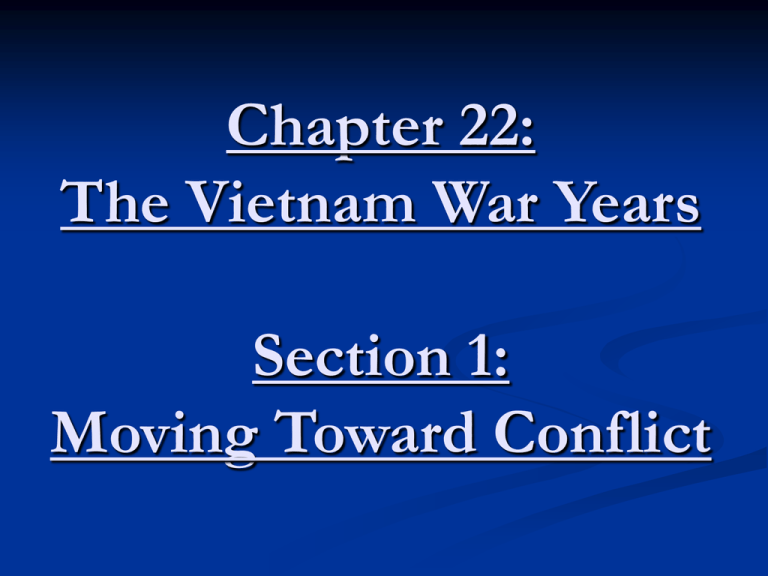22-1 Notes - TeacherWeb
advertisement

Chapter 22: The Vietnam War Years Section 1: Moving Toward Conflict California Academic Standards: 11.9.3 11.9 Students analyze U.S. foreign policy since World War II. .3 Trace the origins and geopolitical consequences (foreign and domestic) of the Cold War and containment policy, including the following: The Vietnam War Objectives: Following lecture and reading of this section, students will be able to: Summarize Vietnam’s history as a French colony and its struggle for independence Examine how the U.S. became involved in the Vietnam conflict Describe the expansion of U.S. military involvement under President Johnson Overview: Tell me and the class about a time when you tried to solve a problem, but instead of getting better, the problem got worse America slowly involved itself in the war in Vietnam as it tried to contain spread of communism The Roots of American Involvement Involvement began in 1950, during French Indochina War. France ruled Indochina (Vietnam, Laos, and Cambodia) from the late 1800s until World War II. The French took a large amount of rice and rubber, and took over Vietnamese peasant’s farms Also the French, in response to opposition by the peasants, took away free speech and assembly rights as well Ho Chi Minh, leader of the Indochinese Communist Party founded in 1930, organized uprisings by peasants, even after he fled in 1930 he organized uprisings in exile from the Soviet Union and later on China. In 1941, a year after the Japanese took control of Vietnam, the Vietminh formed (organization of communists and nationalists that wanted Vietnamese independence, Ho Chi Minh returned. In 1945 declared Vietnam independent, after Japan was defeated in WWII. France moved back into Vietnam in 1946 to regain its colony, but was eventually driven out by the Vietminh Truman and Eisenhower support France’s war against Vietnam, because Vietnam was Communist U.S. provided economic and military support to France to keep France as an ally against the Soviet Union in Europe and to keep communism from spreading to another Asian country, as per the domino theory. The Geneva Accords of 1954 temporarily divide Vietnam (along the 17th parallel) into North Vietnam and South Vietnam until an election to unify the country could be held in 1956. The The United States Steps In U.S. continued to supply economic and military aid to South Vietnam’s non-communist regime South Vietnamese President Ngo Dinh Diem canceled the unifying elections because Ho Chi Minh because of his popularity was sure to win Ho Chi Minh was popular because he was a national hero for his years of fighting the Japanese and French and had broken up large estates in the north and distributed land to peasants. Eisenhower promised U.S. support if Diem would house a reform government in South Vietnam. Corruption and repressive policies are a constant Diem’s regime though. By 1957 the Vietcong [National Liberation Front (NLF)], a Communist group, began attacking Diem’s government. JFK initially strongly supported Diem providing 16,000 military personnel by the end of 1963 In 1963, JFK backed plans to overthrow Diem, who also ends up assassinated after he was overthrown President Johnson expands the conflict Diem’s successors fail to stop the Vietcong’s influence in South Vietnam bringing more chaos to the region and the Vietcong influence began to grow The Tonkin Gulf Resolution of 1964 granted president Johnson broad military powers in Vietnam. In February 1965, President Johnson escalateed U.S. involvement in Vietnam with Operation Rolling Thunder Close After France’s withdrawal from Vietnam, the country was temporarily divided into the Communist controlled North and the Nationalist controlled South. U.S. military involvement escalated in 1965, when President Johnson unleashed the first sustained bombing of North Vietnam.






![vietnam[1].](http://s2.studylib.net/store/data/005329784_1-42b2e9fc4f7c73463c31fd4de82c4fa3-300x300.png)